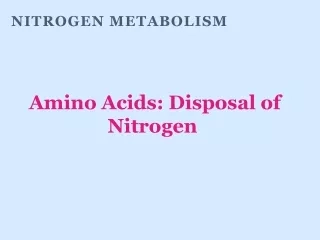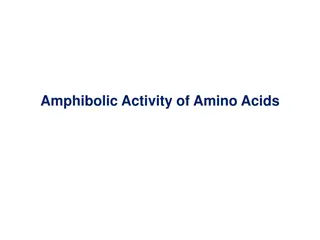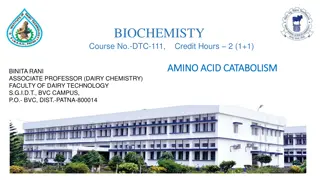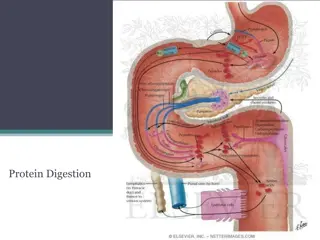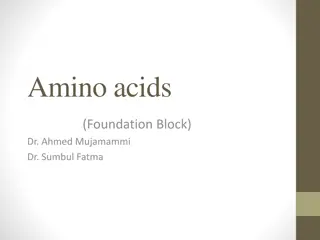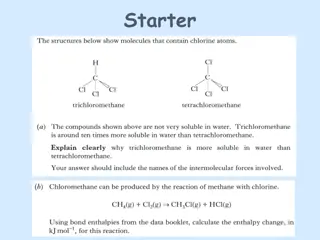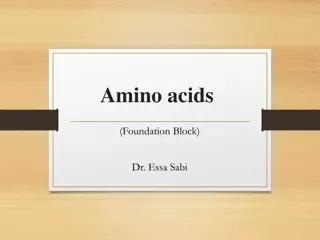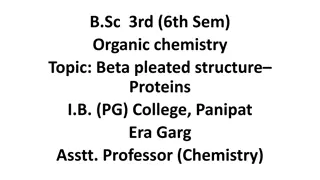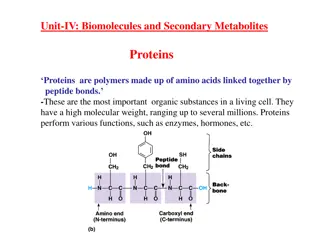Understanding the Structure and Role of Amino Acids in Proteins
Amino acids are building blocks of proteins, with distinct structures and properties. There are 20 common amino acids found in mammalian proteins, each with a carboxyl group, an amino group, and a unique side chain. The side chains determine the role of an amino acid in a protein, classified as nonpolar or polar. Nonpolar amino acids have side chains that promote hydrophobic interactions, crucial for protein folding and stability. Proline stands out due to its rigid structure. Understanding amino acid structures is essential for comprehending protein function and interactions.
Download Presentation

Please find below an Image/Link to download the presentation.
The content on the website is provided AS IS for your information and personal use only. It may not be sold, licensed, or shared on other websites without obtaining consent from the author. Download presentation by click this link. If you encounter any issues during the download, it is possible that the publisher has removed the file from their server.
E N D
Presentation Transcript
Structure of amino acids Although more than 300 different amino acids have been described in nature, only 20 are commonly found as constituents of mammalian proteins. [Note: These are the only amino acids that are coded for by DNA, the genetic material in the cell.] Each amino acid has a carboxyl group, a primary amino group (except for proline, which has a secondary amino group), and a distinctive side chain ( Rgroup ) bonded to the carbon atom (Figure 1A). At physiologic pH (approximately 7.4), the carboxyl group is dissociated, forming the negatively charged carboxylate ion ( COO ), and the amino group is protonated ( NH3+). In proteins, almost all of these carboxyl and amino groups are combined through peptide linkage and, in general, are not available for chemical reaction except for hydrogen bond formation (Figure1B). Thus, it is the nature of the side chains that ultimately dictates the role an amino acid plays in a protein. It is, the reform, useful to classify the amino acids according to the properties of their side chains, that is, whether they are nonpolar (have an even distribution of electrons) or polar (have an uneven distribution of electrons, such as acids and bases) as shown in Figures 2 and 3.
A. Amino acids with nonpolar side chains Each of these amino acids has a nonpolar s ide chain that does not gain or lose protons or participate in hydrogen or ionic bonds (see Figure 2). The side chains of these amino acids can be thought of as oily or lipid- like, a property that promotes hydrophobic interactions. 1. Location of nonpolar amino acids in proteins: In proteins found in aqueous solutions (a polar environment) the side chains of the nonpolar amino acids tend to cluster together in the interior of the protein (Figure 4). This phenomenon, known as the hydrophobic effect, is the result of the hydrophobicity of the nonpolar R groups, which act much like droplets of oil that coalesce in an aqueous environment. The nonpolar R groups, thus, fill up the interior of the folded protein and help give it its three -dimensional shape. However, for proteins that are located in a hydrophobic environment, such as a membrane, the nonpolar R groups are found on the outside surface of the protein, interacting with the lipid environment see Figure 4.
2. Proline: Proline differs from other amino acids in that its side chain and amino N form a rigid, five -member red ring structure (Figure 5). Proline, then, has a secondary (rather than a primary) amino group. It is frequently referred to as an imino acid.


